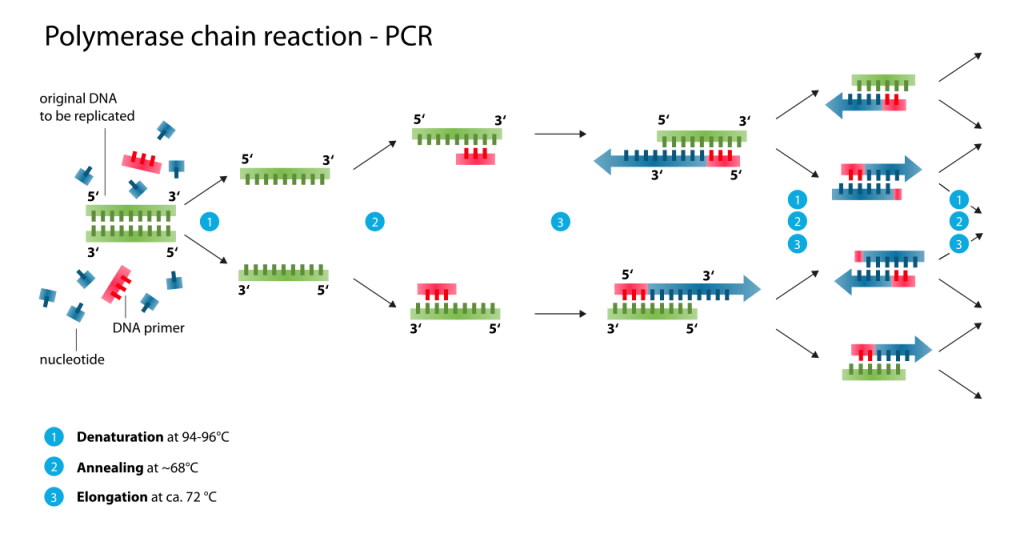Polymerase chain reaction is one of the modern advanced molecular techniques that amplifies the target sequence of DNA and make millions and billions of copies even with an incredibly small amount of DNA sample.
- Amplification by PCR helps in acquiring detailed analysis of the targeted DNA sample.
- PCR was invented in 1983 by Kary Mullis and was awarded with Nobel Prize. Similarly, Micheal Smith was also awarded for his discovery of Taq polymerase, which has a great advantage on PCR process.
- With the help of Taq polymerase, the PCR which is based on thermal cycler with repeated heating and cooling of DNA aided the process that could be done easily and quickly in a simple way by the use of this programmable thermocycler.
- Taq polymerase is derived from the DNA of bacteria called Thermus aquaticus which is a thermophilic bacteria that grows around 90°C and beyond.
- With its thermophilic nature which remains beyond the denaturation temperature, these thermostable polymerase DNA makes the PCR process more achievable without further addition of extra DNA polymerase in each cycle.
- By the use of tiny amount of DNA sample during amplification, problems like contamination of DNA from the air we breathe, contaminants present in pipettes and equipments, mixed reagents and the free floating nucleic acid in the surrounding gives a negative result.
- To minimize these occuring issues several methods, enzymes and reagents have been developed like
- Use of biodegradable pipettes and equipments
- Separating reagents from contaminants
- Use of special nucelotides and primers
- Use of degrading enzymes and chemicals
- PCR additives like formamide, dimethyl sulfoxide, bovine serum albumin, tetramethyl ammonium chloride to increase the specificity.
Components of PCR

Target DNA sequence:
- The gene of interest to be amplified are selected.
Primers:
- Two primer must be designed, one in the starting and other at the end of the target DNA.
- Primase enzyme helps in synthesis of primer and complements to the template region of DNA.
Nucleotides:
- DNA consists of two strand of nucleotides. Each consist of a phosphate group, a deoxyribose sugar and four nitrogen bases.
- These dNTPs only attaches with the 3’-OH group where primer helps in adding the nucleotide to the strand of DNA.
Taq Polymerase:
- Taq polymerase synthesizes and amplifies new strands of DNA.
- Due to its ability of withstanding the denaturing temperature, it replaced the DNA polymerase.
Buffers:
- Potassium chloride (KCl) is used as a buffer which promotes primer annealing in Taq DNA polymerase.
- The pH of the buffer is generally 8 to 9.5.
MgCl2:
- Magnesium chloride boosts the activity of Taq polymerase and increases the amplification process.
LEARN MORE ABOUT: The story behind the PCR (Polymerase Chain Reaction) – The Science Notes
General Protocol for PCR
- Defrost all the reagents on a bowl of ice.
Add all the reagents in following manner with exact concentration as mentioned below:
- Water – to 5µl
- Buffer – 1X
- Taq polymerase – 0.05 units/µl
- dNTPs – 200µM
- MgCl2 – 0.1-0.5mM
- Primers (forward and reverse) – 0.1-0.5µM
- Template – 200pg/µl
- After addition, mix gently by tapping the tube.
- Centrifuge
- Prepare positive control with known DNA templates and negative control without templates.
Major 3 steps of PCR

(Source:https://en.wikipedia.org/wiki/Polymerase_chain_reaction
Step 1: Denaturation
- Initial denaturation is held at 94°C for 5 min where the two strands of DNA helix separates from each other.
- The high temperature breaks the hydrogen bonds of the DNA which acts as a template in further step.
- The temperature must be maintained for a long time and slowly decreasing with the time duration to 15-30 sec.
Step 2: Annealing
- Polymerisation occurs by the binding of primers to the target DNA templates which starts when the temperature is lowered to 50-65°C as the primer used determines the melting temperature (Tm).
- Primers complement to the opposite end of the template DNA as a forward and reverse primer i.e, complements at 5’ end and 3’ end of the template.
Step 3: Extension
- Taq polymerase gets attached to the primer and DNA nucleotides one by one when the temperature is raised again at 72°C for 5 min.
- Brand new double strands of DNA are obtained after the PCR reaction completes.
After the new DNA strands are achieved, electrophoresis methods can be used for the quantification and size evalution of the newly DNA fragments.
Application of PCR in clinical, food and agriculture area:
- PCR is applicable in wide range from clinical diagnosis to the area of food industries and agricultural productions.
- In clinical, the detection of cancer cells and various human disease like tuberculosis, Hepatitis C, Corona virus infection and for the diagnosis of mitochondrial diorders, PCR is used.
- They are also used in gene typing, molecular sequencing and cloning and for the detection of mutagenesis.
- In food industries, biotracing of products, identification of the contaminating source, determination of toxins and food-borne pathogens can be detected by the use of PCR.
- In agricultural sector, PCR is used in quality product and seed development, identification of plant cultivars, processing of grains and gene cloning.
Refrences:
- Caetano-Anollés, D. (2013). Polymerase Chain Reaction. Brenner’s Encyclopedia of Genetics, 392–395. doi:10.1016/b978-0-12-374984-0.01186-4
- Clark, D. P., Pazdernik, N. J., & McGehee, M. R. (2019). Polymerase Chain Reaction. Molecular Biology, 168–198. doi:10.1016/b978-0-12-813288-3.00006-9
- https://www.genscript.com/pcr-protocol-pcr-steps.html
- https://www.sciencelearn.org.nz/resources/2347-what-is-pcr
- https://www.yourgenome.org/facts/what-is-pcr-polymerase-chain-reaction